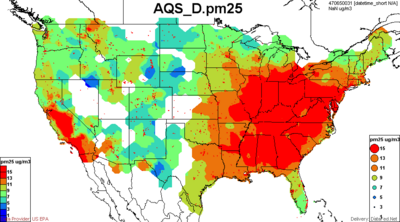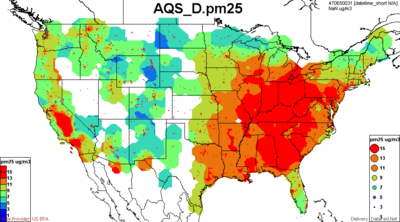Difference between revisions of "NASA ROSES08: Regulatory AQ Applications Proposal- Technical Approach"
| Line 67: | Line 67: | ||
== Application to Other DSS's== | == Application to Other DSS's== | ||
| + | [[Image:2000_04_FRMPM25_Avg.png|400px]] [[Image:2005_08_FRMPM25_Avg.png|400px]] | ||
Revision as of 00:12, June 17, 2008
Air Quality Cluster > Applying NASA Observations, Models and IT for Air Quality Main Page > Proposal | NASA ROSES Solicitation | Context | Resources | Schedule | Forum | Participating Groups
From NRA
As the main body of the proposal, this section should cover the following material:
- Objectives of the proposed activity and relevance to NASA’s Strategic Goals and Outcomes given in Table 1 in the Summary of Solicitation of this NRA;
- Strategic Subgoal 3A: Study planet Earth from space to advance scientific understanding and meet societal needs. - 3A.7 Expand and accelerate the realization of societal benefits from Earth system science.
- Methodology to be employed, including discussion of the innovative aspects and rationale for NASA Earth research results to be integrated;
- Systematic approach to integrate Earth science results into the decision-making activity (existing or new) and to develop and test the integrated system and address integration problems (technical, computational, organizational, etc.);
- Approach to quantify improvements in the system performance, including characterization of risk and uncertainties;
- Approach to quantify (or quantitatively estimate) the socioeconomic value and benefits from the resulting improvements in decision-making;
- Challenges and risks affecting project success (technical, policy, operations, management, etc.) and the approach to address the challenges and risks; and
- Relevant tables/figures that demonstrate key points of the proposal.
Proposals seeking to create a new decision-making activity should describe the tool, system, assessment, etc. in detail, including the decision analysis, factors, unique roles for Earth science research results, and other pertinent information.
From NASA Proposer Guidebook - Technical/Science/Management Section
[Ref.: Appendix B, Parts (c)(4), (c)(5), and in-part (c)(6)] As the main body of the proposal, this section must cover the following topics in the order given, all within the specified page limit. Unless specified otherwise in the NRA, the limit is 15 pages using the default values given in Section 2.3.1:
- The objectives and expected significance of the proposed research, especially as related to the objectives given in the NRA;
- The technical approach and methodology to be employed in conducting the proposed research, including a description of any hardware proposed to be built in order to carry out the research, as well as any special facilities of the proposing organization(s) and/or capabilities of the Proposer(s) that would be used for carrying out the work. (Note: ref. also Section 2.3.10(a) concerning the description of critical existing equipment needed for carrying out the proposed research and the Instructions for the Budget Justification in Section 2.3.10 for further discussion of costing details needed for proposals involving significant hardware, software, and/or ground systems development, and, as may be allowed by an NRA, proposals for flight instruments);
- The perceived impact of the proposed work to the state of knowledge in the field and, if the proposal is offered as a direct successor to an existing NASA award, how the proposed work is expected to build on and otherwise extend previous accomplishments supported by NASA;
- The relevance of the proposed work to past, present, and/or future NASA programs and interests or to the specific objectives given in the NRA;
- To facilitate data sharing where appropriate, as part of their technical proposal, the Proposer shall provide a data-sharing plan and shall provide evidence (if any) of any past data-sharing practices.
The Scientific/Technical/Management Section may contain illustrations and figures that amplify and demonstrate key points of the proposal (including milestone schedules, as appropriate). However, they must be of an easily viewed size and have self-contained captions that do not contain critical information not provided elsewhere in the proposal.
Summary
A description of the key, central objectives of the proposal in terms understandable to a nonspecialist;
A concise statement of the methods/techniques proposed to accomplish the stated research objectives; and
- Fan-in/Fan-out Architecture
- Service Oriented Architecture
- Application to primary and reused in secondary DSS's
A statement of the perceived significance of the proposed work to the objectives of the solicitation and to NASA interests and programs in general.
- Better air quality management decisions
- Wider distribution of NASA products
- Demonstration of GEOSS concept
Architecture
The design philosophy is of fan in-fan out. Any data is applicable to multiple benefit areas. Any benefit area needs multiple data.
Primary Decision-Support Systems
- DataFed - Husar - Exceptional Events. Fan in: 50 States -> 10 EPA Regions -> 1 Federal EPA. Each transmits different pieces of information and we need to determine those pieces.
Exceptional Events are distributed in space, need a wide variety of data and include a variety of people therefore they are good candidates for the modern decision-support systems. Because fan in - fan out data flow architecture is so broad it can help other decision support application areas.
Many data, many analyses, many participants
Other Decision-Support Systems
Same fan in - fan out data flow architecture can be used for different decision-support systems.
- VIEWS - Brett/Shawn - Regional Haze
- BlueSky - Sean - Smoke
- BAMS - McHenry - Air Quality Forecasting for the public
- HTAP - Keating - Hemispheric Transport Policy

